Antigua
Antigua (/ænˈtiːɡ(w)ə/ ann-TEE-g(w)ə),[1] also known as Waladli or Wadadli by the native population, is an island in the West Indies. It is one of the Leeward Islands in the Caribbean region and the main island of the country of Antigua and Barbuda. Antigua and Barbuda became an independent state within the Commonwealth of Nations on 1 November 1981.[2]
| Native name: Waladli or Wadadli | |
|---|---|
Aerial view of Antigua | |
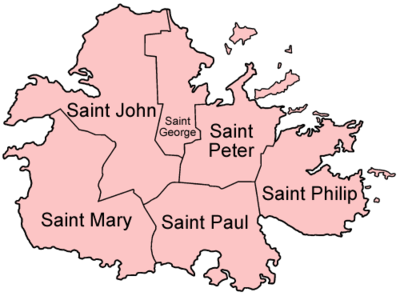 Map of Antigua showing the parishes | |
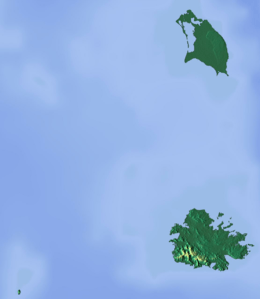 Antigua 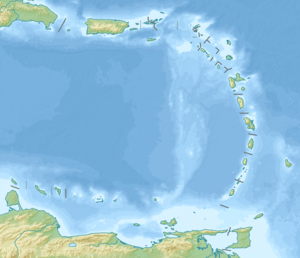 Antigua  Antigua | |
| Geography | |
| Location | Caribbean Sea |
| Coordinates | 17°5′N 61°48′W |
| Archipelago | Leeward Islands |
| Total islands | 1 |
| Area | 281 km2 (108 sq mi) |
| Coastline | 87 km (54.1 mi) |
| Highest elevation | 402 m (1,319 ft) |
| Highest point | Boggy Peak |
| Administration | |
| Largest settlement | St. John's (pop. 22,000) |
| Demographics | |
| Population | 95,882 (July 2018) |
| Pop. density | 285.2/km2 (738.7/sq mi) |
| Ethnic groups | 91% Black, 4.4% Other Mixed Race, 1.7% White, 2.9% Other |
Antigua means "ancient" in Spanish after an icon in Seville Cathedral, "Santa Maria de la Antigua" — St. Mary of the Old Cathedral.[3] The name Waladli[4] comes from the indigenous inhabitants and means approximately "our own". The island's circumference is roughly 87 km (54 mi) and its area 281 km2 (108 sq mi). Its population was 80,161 (at the 2011 Census).[5] The economy is mainly reliant on tourism, with the agricultural sector serving the domestic market.
Over 22,000 people live in the capital city, St. John's. The capital is situated in the north-west and has a deep harbour which is able to accommodate large cruise ships. Other leading population settlements are All Saints (3,412) and Liberta (2,239), according to the 2001 census.
English Harbour on the south-eastern coast provides protected shelter during violent storms. It is the site of a restored British colonial naval station named "Nelson's Dockyard" after Admiral Horatio Nelson. English Harbour and the neighbouring village of Falmouth are yachting and sailing destinations and provisioning centres. During Antigua Sailing Week, at the end of April and beginning of May, an annual regatta brings a number of sailing vessels and sailors to the island to take part in sporting events.
On 6 September 2017, the Category 5 Hurricane Irma destroyed 90 percent of the buildings on the island of Barbuda and the entire population was evacuated to Antigua.[6][7]
History
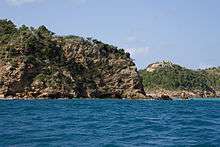

Early Antiguans
The first inhabitants were the Guanahatabey people. Eventually, the Arawak migrated from the mainland, followed by the Carib. Prior to European colonialism, Christopher Columbus was the first European to visit Antigua, in 1493.[8]
The Arawak were the first well-documented group of indigenous people to settle Antigua. They paddled to the island by canoe (piragua) from present-day Venezuela, pushed out by the Carib, another indigenous people. The Arawak introduced agriculture to Antigua and Barbuda. Among other crops, they cultivated the Antiguan "Black" pineapple. They also grew Corn, Sweet potatoes (white with firmer flesh than the bright orange "sweet potato" grown in the United States), Chili peppers, Guava, Tobacco, and Cotton.
Some of the vegetables listed, such as corn and sweet potatoes, continue to be staples of Antiguan cuisine. Colonists took them to Europe, and from there, they spread around the world. For example, a popular Antiguan dish, dukuna (/ˈduːkuːnɑː/), is a sweet, steamed dumpling made from grated sweet potatoes, flour and spices. Another staple, fungi (/ˈfuːndʒi/), is a cooked paste made of cornmeal and water.
Most of the Arawak left Antigua about A.D. 1100. Those who remained were raided by the Carib coming from Venezuela. According to The Catholic Encyclopedia, the Caribs' superior weapons and seafaring prowess allowed them to defeat most Arawak nations in the West Indies. They enslaved some and cannibalised others.[9] Watson points out that the Caribs had a much more warlike culture than the Arawak.[9]
The indigenous people of the West Indies built excellent sea vessels, which they used to sail the Atlantic and Caribbean resulting in much of the South American and the Caribbean islands being populated by the Arawak and Carib. Their descendants live throughout South America, particularly Brazil, Venezuela and Colombia.
British
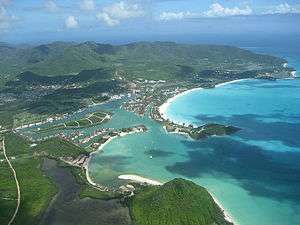
Christopher Columbus named the island "Antigua" in 1493 in honour of the "Virgin of the Old Cathedral"[3] (Spanish: La Virgen de la Antigua) found in Seville Cathedral in southern Spain. On his 1493 voyage, honouring a vow, he named many islands after different aspects of St. Mary, including Montserrat and Guadaloupe.
In 1632, a group of English colonists left St. Kitts to settle on Antigua. Sir Christopher Codrington, an Englishman, established the first permanent British settlement.[8] The island rapidly developed as a profitable sugar colony. For a large portion of Antigua history, the island was considered Britain's "Gateway to the Caribbean". It was located on the major sailing routes among the region's resource-rich colonies. Lord Horatio Nelson, a major figure in Antigua history, arrived in the late 18th century to preserve the island's commercial shipping prowess.
According to A Brief History of the Caribbean,[10] British diseases, malnutrition and slavery eventually destroyed the vast majority of the Caribbean's native population. There are some differences of opinions as to the relative importance of these causes.
Slavery
%2C_plate_II_-_BL.jpg)
%2C_plate_VI_-_BL.jpg)
%2C_plate_X_-_BL.jpg)
Sugar became Antigua's main crop in about 1674, when Christopher Codrington (c 1640-1698) settled at Betty's Hope plantation. He came from Barbados, bringing the latest sugar technology with him. Betty's Hope, Antigua's first full-scale sugar plantation, was so successful that other planters turned from tobacco to sugar. This resulted in their importing slaves to work the sugar cane crops.[8]
According to A Brief History of the Caribbean, many West Indian colonists initially tried to use locals as slaves. These groups succumbed easily to disease and/or malnutrition, and died by the thousands. The enslaved Africans adapted better to the new environment and thus became the number one choice of unpaid labour; they also provided medical services and skilled labour, including carpentry, for their masters. However, according to a Smithsonian Institution article, the West African slave population in the Caribbean also had a high mortality rate, which was compensated by regular imports of very high numbers of new slaves from West and Central Africa.[11]
Sugar cane was one of the most grueling and dangerous crops slaves were forced to cultivate. Harvesting cane required backbreaking long days in sugar cane fields under the hot island sun. Sugar cane spoiled quickly after harvest, and the milling process was slow and inefficient, forcing the mill and boiling house to operate 24 hours a day during harvest season.
Sugar mills and boiling houses were two of the most dangerous places for slaves to work on sugar plantations. In mills wooden or metal rollers were used to crush cane plants and extract the juices. Slaves were at risk of getting their limbs stuck and ripped off in the machines. Similarly, in sugar boiling houses slaves worked under extremely high temperatures and at the risk of being burned in the boiling sugar mixture or getting their limbs stuck.
Today, collectors prize the uniquely designed colonial furniture built by West Indian slaves. Many of these works feature what are now considered "traditional" motifs, such as pineapples, fish and stylized serpents.
By the mid-1770s, the number of slaves had increased to 37,500, up from 12,500 in 1713. The British population had fallen from 5,000 to below 3,000.[12] The slaves lived in wretched and overcrowded conditions and could be mistreated or even killed by their owners with impunity. The Slave Act of 1723 made arbitrary murder of slaves a crime, but did not do much to ease their lives.[13]
Unrest against enslavement among the Black Antiguans became increasingly common. In 1729, a man named Hercules was hanged, drawn, and quartered and three others were burnt alive, for conspiring to kill the slave owner Crump and his family. In 1736, an enslaved man called "Prince Klaas" (whose slave name was Court) allegedly planned an uprising in which British slavers would be massacred. Court was crowned "King of the Coromantees" in a pasture outside the capital of St. John's. The coronation appeared to be just a colourful spectacle but was, for the enslaved people, a ritual declaration of war on the British slavers. Due to information obtained from other slaves, colonists discovered the plot and suppressed it. Prince Klaas and four accomplices were caught and executed by the breaking wheel. (However, some doubts exist about Court's guilt.)[14][11] Six of the rebels were hanged in chains and starved to death, and another 58 were burned at the stake. The site of these executions is now the Antiguan Recreation Ground.[15][11]
The American War of Independence in the late 18th century disrupted the Caribbean sugar trade. At the same time, public opinion in Great Britain gradually turned against slavery.[16] "Traveling ... at slavery's end, [Joseph] Sturge and [Thomas] Harvey (1838 ...) found few married slaves residing together or even on the same estate. Slaveholders often counted as 'married' only those slaves with mates on the estate."[17][lower-alpha 1][lower-alpha 2][lower-alpha 3] Great Britain abolished the slave trade in 1807, and all existing slaves were emancipated in 1834.[8]
Horatio, Lord Nelson
Horatio Nelson (who was created 1st Viscount Nelson in 1801) was Senior Naval Officer of the Leeward Islands from 1784 to 1787 on HMS Boreas. During his tenure, he tried to enforce the Navigation Acts. These acts prohibited trade with the newly formed United States of America. Most of the merchants in Antigua depended upon American trade, so many of them despised Captain Nelson. As a result, he was unable to get a promotion for some time after his stint on the island.
Unlike the Antiguan merchants, Nelson had a positive view of the controversial Navigation Acts:[18]
The Americans were at this time trading with our islands, taking advantage of the register of their ships, which had been issued while they were British subjects. Nelson knew that, by the Navigation Act, no foreigners, directly or indirectly, are permitted to carry on any trade with these possessions. He knew, also, that the Americans had made themselves foreigners with regard to England; they had disregarded the ties of blood and language when they acquired the independence which they had been led on to claim, unhappily for themselves, before they were fit for it; and he was resolved that they should derive no profit from those ties now. Foreigners they had made themselves, and as foreigners they were to be treated.[18]
Nelson said: "The Antiguan Colonists are as great rebels as ever were in America, had they the power to show it."[18]
A dockyard started in 1725, to provide a base for a squadron of British ships whose main function was to patrol the West Indies and thus maintain Britain's sea power, was later named "Nelson's Dockyard" in his honour.
While Nelson was stationed on Antigua, he frequently visited the nearby island of Nevis, where he met and married a young widow, Fanny Nisbet, who had previously married the son of a plantation family on Nevis.
1918 labour unrest
Following the foundation of the Ulotrichian Universal Union, a friendly society which acted as a trade union (which were banned), the sugar cane workers were ready to confront the plantation owners when they slashed their wages. The cane workers went on strike and rioted when their leaders were arrested.[19]
Independence
In 1968, with Barbuda and the tiny island of Redonda as dependencies, Antigua became an associated state of the Commonwealth, and in 1981 it was disassociated from Britain.[8]
U.S. government presence
Until July 7, 2015, the United States Air Force maintained a small base near the airport, designated Detachment 1, 45th Operations Group, 45th Space Wing (known as Antigua Air Station). The mission provided high rate telemetry data for the Eastern Range and its space launches. The unit was deactivated due to US government budget cuts and the property given to the Antiguan Government.[20]
Commissioned, 9 August 1956, the Naval Facility (NAVFAC) Antigua was one of the shore terminal stations that were part of the Sound Surveillance System (SOSUS) and the Integrated Undersea Surveillance System (IUSS), which were used to track Soviet submarines. NAVFAC Antigua was decommissioned 4 February 1984.[21]
Demographics
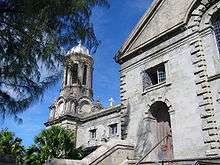
Geography
Located in the Leeward Islands Antigua has an area of 281 square kilometres (108 sq mi) with 87 kilometres (54 mi) of coastline. The highest elevation on the island is 402 metres (1,319 ft).
Various natural points, capes, and beaches around the island include: Boon Point, Beggars Point, Parham, Willikies, Hudson Point, English Harbour Town, Old Road Cape, Johnson's Point, Ffryes Point, Jennings, Five Islands, and Yepton Beach, and Runaway Beach.
Several natural harbours are formed by these points and capes, including: Fitches Creek Bay, between Beggars Point and Parham; Nonsuch Bay between Hudson Point and Willikies; Willoughby Bay, between Hudson Point and English Harbour Town; English Harbour leading into English Harbour Town; Falmouth Harbour recessing into Falmouth; Rendezvous Bay between Falmouth and Old Road Cape; Five Islands Harbour, between Jennings and Five Islands; and Green Bay, the main harbour at St. John's, between Yepton Beach and Runaway Beach.
Fauna
The Antiguan racer is among the rarest snakes in the world. The Lesser Antilles are home to four species of racers. All four have undergone severe range reductions; at least two subspecies are extinct and another, A. antiguae, now occupies only 0.1 percent of its historical range.[22]
Griswold's ameiva (Ameiva griswoldi) is a species of lizard in the genus Ameiva. It is endemic to Antigua and Barbuda. It is found on both islands.
Governance
Local government is provided by six civil parishes: St. George, Saint Peter, Saint Philip, Saint Paul, Saint Mary, and Saint John.
Economy
The country's official currency is the East Caribbean dollar. Given the dominance of tourism, many prices in tourist-oriented businesses are shown in US dollars. The EC dollar is pegged to the US dollar at a varied rate and averages about US$1 = EC$2.7.
Tourism
Antigua's economy relies largely on tourism, and the island is promoted as a luxury Caribbean escape. Many hotels and resorts are located around the coastline. The island's single airport, VC Bird Airport, is served by several major airlines, including Virgin Atlantic, British Airways, American Airlines, United Airlines, Delta Air Lines, Caribbean Airlines, Air Canada, WestJet, and JetBlue. There is regular air service to Barbuda.
Education
Antigua has two international primary/secondary schools: CCSET International, which offers the Ontario Secondary School Diploma, and Island Academy, which offers the International Baccalaureate. There are also many other private schools but these institutions tend to follow the same local curriculum (CXCs) as government schools.
The island of Antigua currently has two foreign-owned for-profit offshore medical schools, the American University of Antigua (AUA),[23] founded in 2004, and The University of Health Sciences Antigua (UHSA),[24] founded in 1982. The island's medical schools cater mostly to foreign students but contribute to the local economy and health care.
Online gambling
Antigua was one of the very first nations to legalize, license, and regulate online gambling and is a primary location for incorporation of online gambling companies. Some countries, most notably the United States, argue that if a particular gambling transaction is initiated outside the country of Antigua then that transaction is governed by the laws of the country where the transaction was initiated. This argument was brought before World Trade Organization and was deemed incorrect.[25]
In 2006, the United States Congress voted to approve the Unlawful Internet Gambling Enforcement Act which criminalized the operations of offshore gambling operators which take wagers from American-based gamblers. This was a prima facie violation of the GATS treaty obligations enforced by the WTO, resulting in a series of rulings unfavorable to the US.
On 21 December 2007, an Article 22 arbitration panel ruled that the United States' failure to comply with WTO rules would attract a US$21 million sanction.[26]
The WTO ruling was notable in two respects:
First, although technically a victory for Antigua, the $21 million was far less than the US$3.5 billion which had been sought; one of the three arbitrators was sufficiently bothered by the propriety of this that he issued a dissenting opinion.
Second, a rider to the arbitration ruling affirmed the right of Antigua to take retaliatory steps in view of the prior failure of the US to comply with GATS. These included the rare, but not unprecedented, right to disregard intellectual property obligations to the US.[27]
Antigua's obligations to the US in respect of patents, copyright, and trademarks are affected. In particular, Berne Convention copyright is in question, and also material not covered by the Berne convention, including TRIPS accord obligations to the US. Antigua may thus disregard the WIPO treaty on intellectual property rights, and therefore the US implementation of that treaty (the Digital Millennium Copyright Act, or DMCA)—at least up to the limit of compensation.[28]
Since there is no appeal to the WTO from an Arbitration panel of this kind, it represents the last legal word from the WTO on the matter. Antigua is therefore able to recoup some of the claimed loss of trade by hosting (and taxing) companies whose business model depends on immunity from TRIPS provisions.[29]
Software company SlySoft was based in Antigua, allowing it to avoid nations with laws that are tough on anti-circumvention of technological copyright measures, in particular the DMCA in the United States.[30]
Banking
Swiss American Bank Ltd., later renamed Global Bank of Commerce, Ltd, was formed in April 1983 and became the first Off-shore International Financial institution governed by the International Business Corporations, Act of 1982 licensed bank in Antigua.[31] The bank was later sued by the United States for failure to release forfeited funds from one of its account holders.[32] Swiss American Bank was founded by Bruce Rappaport.[33]
Stanford International Bank was formed by Allen Stanford in 1986 in Montserrat where it was called Guardian International Bank. On 17 February 2009, the U.S. Securities and Exchange Commission charged Allen Stanford, Laura Pendergest-Holt and James Davis with fraud[34][35][36] in connection with the bank's US$8 billion certificate of deposit (CD) investment scheme that offered "improbable and unsubstantiated high interest rates".[37] This led the federal government to freeze the assets of the bank and other Stanford entities.[34][38] On 27 February 2009, Pendergest-Holt was arrested by federal agents in connection with the alleged fraud.[39] On that day, the SEC said that Stanford and his accomplices operated a "massive Ponzi scheme", misappropriated billions of investors' money and falsified the Stanford International Bank's records to hide their fraud. "Stanford International Bank's financial statements, including its investment income, are fictional," the SEC said.[35][40]
Antigua Overseas Bank (AOB) was part of the ABI Financial Group and was a licensed bank in Antigua. On 13 April 2012, AOB was placed into receivership by the government of Antigua.[41]
On 27 November 2018, Scotiabank, the leading commercial bank on the island, announced plans to sell its banking operations in Antigua and 9 other non-core Caribbean markets to Republic Financial Holdings Limited.[42]
Sport
The major Antiguan sport is cricket. Sir Vivian ("Viv") Richards is one of the most famous Antiguans, who played for, and captained, the West Indies cricket team. Richards scored the fastest Test century at the Antigua Recreation Ground, it was also the venue at which Brian Lara twice broke the world record for an individual Test innings (375 in 1993/94, 400 not out in 2003/04). Antigua was the location of a 2007 Cricket World Cup site, on a new Recreation Ground constructed on an old cane field in the north of the island. Both football (soccer) and basketball are becoming popular among the island youth. There are several golf courses in Antigua. Daniel Bailey was the first athlete to win a global world medal at the 2010 IAAF World Indoor Championships.
Being surrounded by water, sailing is one of the most popular sports with Antigua Sailing Week and Antigua Classic Yacht Regatta being two of the region's most reputable sailing competitions. Hundreds of yachts from around the world compete around Antigua each year. Sport Fishing is also a very popular sport with several big competitions held yearly. Windsurfing was very popular until kite-surfing came to the island. Kitesurfing or kite-boarding is very popular at Jabbawock Beach.
Notable residents
- Curtly Ambrose, legendary West-Indian cricketer[43]
- Giorgio Armani, Italian fashion designer; owns a home near Deep Bay[44]
- Calvin Ayre, billionaire founder of internet gambling company Bodog Entertainment Group[45]
- Silvio Berlusconi, former Italian Prime Minister[46]
- Richard Branson, Virgin Atlantic mogul[47]
- Mehul Choksi, alleged scamster, diamond merchant and owner of Gitanjali Jewelers
- Eric Clapton, established an Antiguan drug treatment centre; has a home on the south of the island[48]
- Melvin Claxton, Pulitzer Prize-winning journalist[49]
- Timothy Dalton, actor of James Bond fame[50]
- Ken Follett, the author of Eye of the Needle, owns a house on Jumby Bay[50]
- Marie-Elena John, Antiguan writer and former African Development Foundation specialist. Her debut novel, Unburnable, was selected Best Debut of 2006 by Black Issues Book Review[51]
- SD Jones, professional wrestler known as "Special Delivery Jones" in the WWE in the 1970s and 1980s
- Phil Keoghan, host of The Amazing Race, lived here during part of his childhood
- Jamaica Kincaid, novelist famous for her writings about life on Antigua. Her 1988 book A Small Place was banned under the Vere Bird administration
- Robin Leach of Lifestyles of the Rich and Famous fame.[52]
- Archibald MacLeish, poet and (U.S.) Librarian of Congress.
- Rachel Lambert Mellon, horticulturist and philanthropist, has owned a compound in Antigua's Half Moon Bay since the 1950s.
- Fred Olsen (1891–1986), inventor of the ball propellant manufacturing process[53]
- Mary Prince, abolitionist and autobiographer, who wrote The History of Mary Prince (1831), the first account of the life of a Black woman to be published in the United Kingdom.
- Viv Richards, West Indian cricket legend; the Sir Vivian Richards Stadium in Antigua was named in his honour[54]
- Richie Richardson, former West-Indies cricket team captain[55]
- Andy Roberts, the first Antiguan to play Test cricket for the West Indies. He was a member of the West Indies teams that won the 1975 and 1979 World Cups.[56]
- Andriy Mykolayovych Shevchenko, Former Ukrainian footballer and politician.
- Peter Stringfellow, British nightclub owner
- Thomas J. Watson Jr., CEO of IBM
- Oprah Winfrey, talk-show host[57]
See also
- Geology of Antigua and Barbuda
- Barbuda Land Acts
- Bibliography of Antigua and Barbuda
- Chief Justices
- Commonwealth of Nations
- Guns for Antigua
- Index of Antigua and Barbuda-related articles
- Leeward Islands
- List of Antiguans and Barbudans
- Outline of Antigua and Barbuda
References
Explanatory notes
- Joseph Sturge, English abolitionist
- Thomas Harvey
- Estate, real estate and houses on it
Citations
- Wells, J. C. (2000). Longman Pronunciation Dictionary (2nd ed.). Harlow, Essex: Longman. p. 33. ISBN 0-582-36467-1.
- "Antigua Culture: Antigua & Barbuda Independence Festival". www.antiguanice.com.
- Kessler, Herbert L. & Nirenberg, David. Judaism and Christian Art: Aesthetic Anxieties from the Catacombs to Colonialism. Accessed 23 September 2011.
- Murphy, Reg. "Common Myths". Archaeology Antigua. Waladli versus Wadadli. Retrieved 4 September 2014.
- CIA, The World Factbook. Retrieved 2 February 2012.
- News, ABC. "ABC News". ABC News. Archived from the original on 10 September 2017. Retrieved 8 September 2017.
- "For first time in 300 years, there's not a single living person on the island of Barbuda".
- "A Plan of the Estate Called Jonas's Situated in the Division of North Sound in the Island of Antigua, the Property of Peter Langford Brooke, Esquire". World Digital Library. Retrieved 19 April 2013.
- Watson, Jack Brierley (1979). The West Indian Heritage: A history of the West Indies. London: Murray. pp. 9–10. ISBN 978-0-7195-3541-3. See also The Catholic Encyclopedia entries for "Arawaks" and "Caribs".
- Rogoziński, Jan (1999). A Brief History of the Caribbean: From the Arawak and Carib to the Present (second ed.). New York: Facts on File. ISBN 978-0-8160-3812-1.
- Dash, Mike (2 January 2013). "Antigua's Disputed Slave Conspiracy of 1736". Smithsonian Institution.
- Brian Dyde. A History of Antigua.
- Dyde, B. (2000). A history of Antigua: The unsuspected isle. Interlink Publishing Group Incorporated.
- Dash, Mike. "A little bit of background – the crucifixion of Prince Klaas". allkindsofhistory.wordpress.com. Retrieved 12 July 2014.
- Brian Dyde, A History of Antigua, London & Oxford: Macmillan Education, 2000.
- Oldfield, Dr John (17 February 2011). "British Anti-slavery".
- Morrissey, Marietta, Slave Women in the New World: Gender Stratification in the Caribbean. Lawrence, Kans.: University Press of Kansas, 1989 (ISBN 0-7006-0394-8), p. 85 and see p. 99 (author assoc. prof. sociology, University of Toledo).
- Robert Southey. The Life of Horatio Lord Nelson.
- Rothermund, Dietmar (2006). The Routledge Companion to Decolonization. Routledge. ISBN 978-0-203-00264-3.
- 1st Lt. Alicia Wallace. "45th SW says Farewell to Antigua Air Station". Patrick.af.mil. Archived from the original on 13 July 2015. Retrieved 2015-12-23.
- Commander, Undersea Surveillance. "Naval Facility Antiqua August 1956 - February 1984". Retrieved 16 February 2020.
- Sajdaka, Richard A.; Henderson, Robert W. (1991). "Status of West Indian racers in the Lesser Antilles". Oryx. 25 (1): 33–38. doi:10.1017/s0030605300034049.
- "American University of Antigua, College of Medicine". Archived from the original on 22 August 2007. Retrieved 23 August 2007.
- "University of Health Sciences Antigua". Retrieved 23 August 2007.
- "WTO - dispute settlement - the disputes - DS285". www.wto.org.
- "US TKOs Antigua in bizarre WTO arbitration decision".
- Kanter, James; Rivlin, Gary (22 December 2007). "In Trade Ruling, Antigua Wins a Right to Piracy" – via NYTimes.com.
- "Antigua/Barbuda govt. official statement".
- "Antigua Government Set to Launch "Pirate" Website To Punish United States - TorrentFreak". 24 January 2013.
- "slysoft.com". www.slysoft.com.
- "Antigua & Barbuda Archive Newsletter, Issue No. 64, April 2002". Archived from the original on 22 June 2013. Retrieved 1 September 2012.
- "United States Court of Appeals, First Circuit. UNITED STATES of America, Plaintiff, Appellant, v. SWISS AMERICAN BANK, LTD., et al., Defendants, Appellees". No. 99-1012. 8 September 1999.
- "Rappaport dies", Antigua Observer, 9 January 2010.
- "Stanford Financial charged with 'massive' fraud". Stuff.co.nz. New Zealand. Reuters. 23 February 2009. Retrieved 4 September 2014.
- Anna Driver (17 February 2009). "U.S. agents enter Stanford Financial Houston office". Reuters. Retrieved 24 November 2011.
- Greenberg, Duncan (17 February 2009). "Billionaire Stanford Charged With Fraud". forbes.com. Retrieved 17 February 2009.
- Goldfarb, Zachary A. (17 February 2009). "SEC Charges Stanford Financial in $8B Fraud". washingtonpost.com. Retrieved 17 February 2009.
- Fitzgerald, Alison (17 February 2009). "Stanford International Bank Said to Bar Withdrawals Amid Probe". bloomberg.com. Retrieved 17 February 2009.
- Jagger, Suzy (27 February 2009). "Top Stanford official Laura Pendergest-Holt charged with obstruction". The Times. London. Retrieved 24 May 2010.
- "New SEC Complaint Says Stanford Ran Ponzi Scheme", The Wall Street Journal, 27 February 2009.(subscription required)
- "Offshore bank placed under receivership", Antigua Observer, 13 April 2012.
- "Scotiabank announces new partnership, selling banks in the Eastern Caribbean". Antigua Observer Newspaper. 27 November 2018. Retrieved 17 February 2019.
- "Curtly Ambrose official website". Retrieved 17 April 2015.
- Tahna Weston (7 January 2006). "SUN Weekend". Archived from the original on 2 December 2008. Retrieved 22 August 2008.
- "Calvin Ayre still living it up in Antigua". TechVibes
- Alex Rose, "Berlusconi, Antigua, Report, Question Marks", 18 October 2010.
- "Antigua and Barbuda: Murder rate higher than in New York – Scotsman.com News". The Scotsman. Edinburgh. 29 July 2008. Archived from the original on 1 August 2008. Retrieved 22 August 2008.
- "Eric Clapton to auction guitars to benefit drug recovery cente – Aggielife". 24 June 2004. Archived from the original on 2 December 2008. Retrieved 22 August 2008.
- http://www.pulitzer.org
- Kevin Brass (12 September 2006). "Antigua recaptures its reputation for chic – International Herald Tribune". Archived from the original on 9 May 2006. Retrieved 22 August 2008.
- Akeem Lasisi (18 August 2008). "Chimamanda in town for Fidelity Creative Workshop". Archived from the original on 17 August 2008. Retrieved 22 August 2008.
- Charles D. Sherman (19 February 2002). "U.S. probes Cuban dolphin deals / The Miami Herald, Cuba News / Noticias – CubaNet News". Archived from the original on 2 September 2002. Retrieved 22 August 2008.
- Saxon, Wolfgang (10 November 1986). "Dr. Fred Olsen, Industrial Chemist, Art Collector and Scholar, is Dead". The New York Times. Retrieved 20 February 2015.
- "Putting Antigua on the map". BBC News. 7 March 2002. Archived from the original on 10 June 2003. Retrieved 22 August 2008.
- "Richie Richardson cricket academy at Antigua". Retrieved 17 April 2015.
- "CaribbeanCricket.com – The Independent Voice of West Indies Cricket". 15 February 2004. Archived from the original on 19 October 2007. Retrieved 22 August 2008.
- "The FABULOUS Homes, Planes, And Other Toys Of Oprah Winfrey".
Bibliography
- Antigua Nice (The Antigua Nice article was extracted by D.V. Nicholson's writings for the Antigua Historic Sites and Conservation Commission.)
- The Torture Museum Site
- The Life of Horatio Lord Nelson by Robert Southey
- The Catholic Encyclopedia
- Veranda Magazine, Island Flourish: West Indian Furnishings by Dana Micucci, March – April 2004
- A Brief History of the Caribbean from the Arawak and the Carib to the Present, by Jan Rogozinski, Penguin Putnam, Inc September 2000
- Article on Antiguan real estate.
Further reading
- Jedidiah Morse (1797), "Antigua", The American Gazetteer, Boston, Massachusetts: At the presses of S. Hall, and Thomas & Andrews
External links


- Government of Antigua and Barbuda
- Map of Antigua
- Antigua Barbuda Department of Tourism
- Antigua Tourism Guide
- Antigua at Curlie